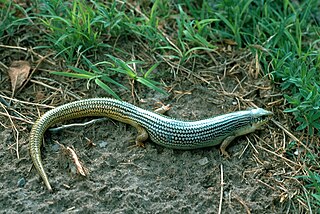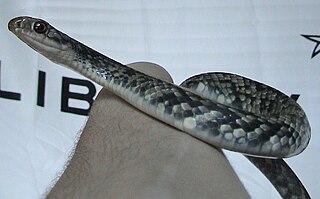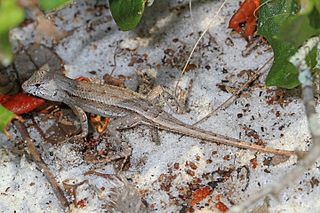
The Great Plains skink is a species of lizard endemic to North America.

The prairie skink is a species of skink endemic to the prairies east of the Rocky Mountains in North America. It is one of only seven species of lizards that occur in Canada.

Plestiodon multivirgatus, commonly known as the many-lined skink, the northern many-lined skink, or the variable skink, is a medium-sized species of lizard, a member of the North American skink genus Plestiodon in the family Scincidae. The species is native to the western United States.

Gambelia sila, commonly known as the blunt-nosed leopard lizard, is a species of lizard in the family Crotaphytidae. The species is endemic to southern California.

The Baja California leopard lizard, also known commonly as Cope's leopard lizard, is a species of lizard in the family Crotaphytidae. The species is endemic to Baja California and adjacent southern California.

The Baja California collared lizard or Baja black-collared lizard is a species of lizard in the family Crotaphytidae. The species is endemic to southern California and Baja California (Mexico).

Tropidoclonion is a genus of snake in the subfamily Natricinae of the family Colubridae. The genus is monotypic, containing the sole species Tropidoclonion lineatum, commonly known as the lined snake. The species is endemic to North America.

The long-nosed snake is a species of nonvenomous snake in the family Colubridae. The species is endemic to North America. It has two recognized subspecies. The other species in the genus were previously considered subspecies.

The Texas alligator lizard is a species of lizard in the subfamily Gerrhonotinae of the family Anguidae. The species is endemic to the central region of the American state of Texas, and south into adjacent northern Mexico.

Crotaphytus reticulatus, commonly called the reticulate collared lizard, is a species of moderately sized lizard in the family Crotaphytidae. The species is native to semiarid, rocky regions of the Tamaulipan mezquital. Its range includes the US state of Texas and the Mexican states of Coahuila, Nuevo León, and Tamaulipas. Of all the species in the family Crotaphytidae, C. reticulatus is the only species which is not restricted to rocky habitats.

The eastern racer, or North American racer, is a species of nonvenomous snake in the family Colubridae. The species is endemic to North America and Central America. Eleven subspecies, including the nominotypical subspecies, are recognized, which as a group are commonly referred to as the eastern racers. The species is monotypic in the genus Coluber.

Holbrookia maculata, commonly known as the lesser earless lizard, is a species of lizard in the family Phrynosomatidae. The species is native to the southwestern and central United States and northern Mexico. There are eight recognized subspecies.

Sceloporus merriami, commonly known as the canyon lizard, is a species of lizard in the family Phrynosomatidae. The species is native to the south-western United States and northern Mexico.

The Texas lyre snake is a species of mildly venomous, rear-fanged snake in the family Colubridae. The species is endemic to the southwestern United States and adjacent northern Mexico.

The Big Bend slider, also called commonly the Mexican Plateau slider and la jicotea de la meseta mexicana in Mexican Spanish, is a species of aquatic turtle in the family Emydidae. The species is native to the Southwestern United States and northern Mexico.

Rhineura floridana, known commonly as the Florida worm lizard, graveyard snake, or thunderworm, is a species of amphisbaenian in the family Rhineuridae. The species is the only extant member of the genus Rhineura, and is found primarily in Florida but has been recorded in Lanier County, Georgia. There are no subspecies that are recognized as being valid.

The crayfish snake, also known commonly as the glossy crayfish snake, the glossy swampsnake, the glossy water snake, and the striped water snake, is a species of semiaquatic snake in the subfamily Natricinae of the family Colubridae. The species is endemic to the southeastern United States, and preys mainly on crayfish.

The Sonoran collared lizard is a species of lizard in the family Crotaphytidae. The species is endemic to the U.S. state of Arizona and the Mexican state of Sonora.

The Florida scrub lizard is a species of lizard in the family Phrynosomatidae. The species is endemic to Florida, the United States.

Thamnophis proximus, commonly known as the western ribbon snake or western ribbonsnake, is a species of garter snake in the subfamily Natricinae of the family Colubridae. The species is found in the central and southern United States, Mexico, and Central America south to central Costa Rica. The species has six recognized subspecies.






















